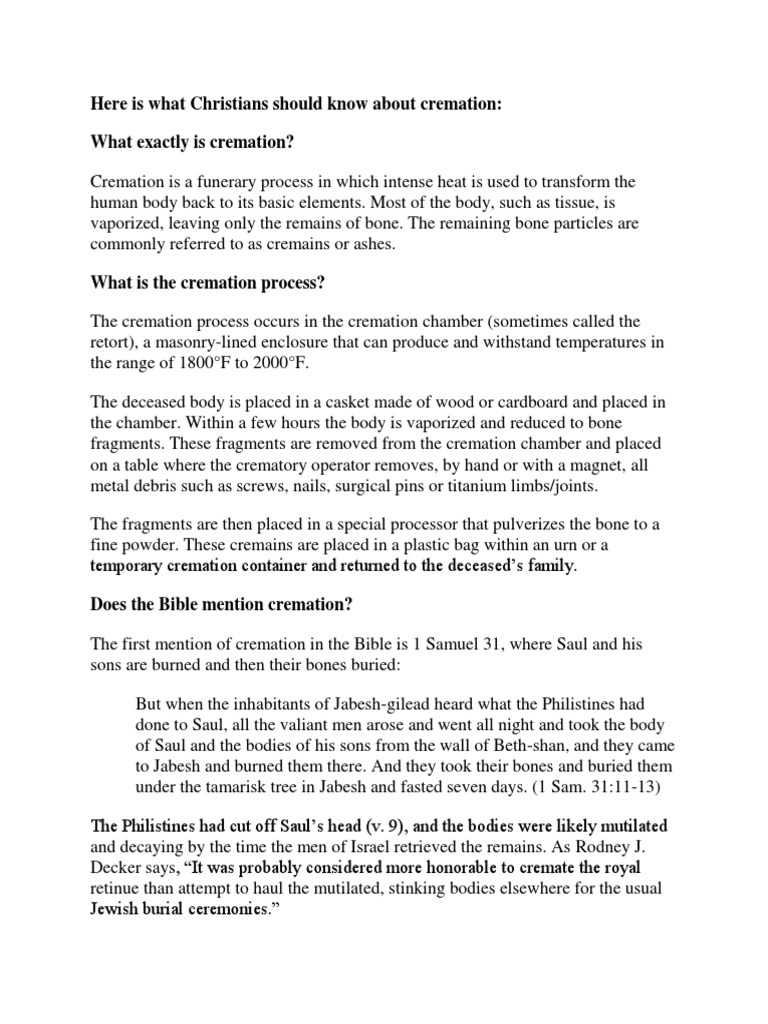The Bahá’í faith, with its profound insights into the nature of existence and the afterlife, provides a unique lens through which to examine the subject of death and the practices associated with it, including cremation. In this discourse, one can explore the intricate relationship between cremation and the teachings of Bahá’u’lláh, the founder of the Bahá’í faith, and how this practice reflects broader spiritual principles that govern the transition from the material realm to the spiritual. Through an examination of metaphorical interpretations and ethical reflections, the implications of cremation, both symbolically and practically, will unveil a deeper understanding of death itself.
To commence, one may consider death as a threshold rather than a terminus. Within the Bahá’í framework, life is perceived as a continuum, a glorious ascent towards ever-increasing proximity to the Creator. The metaphor of a “cocoon” serves to illustrate this transformative journey: just as a caterpillar weaves itself into a protective shell to emerge as a resplendent butterfly, so too does the soul undergo a metamorphosis at the time of death, relinquishing its earthly vestments to ascend to a higher state of existence. Herein lies a critical reflection on cremation; this practice can be viewed as a means of facilitating that transition, as it symbolizes the dissolution of the physical body to free the spirit for its destined flight into the realms of the divine.
In Bahá’í teachings, the physical body is esteemed yet transient; it serves merely as a vessel for the spirit during its earthly sojourn. Thus, the choice of cremation—burning the physical form—raises pertinent questions about attachment and the disposition of material remains. While some may regard cremation as an affront to the sanctity of the human body, within the Bahá’í perspective, it can be embraced as a practical and dignified method of honoring the deceased. Central to this is the understanding that the essence of human life is spiritual, and hence physical remains hold no eternal significance. This is contrary to many traditional beliefs that impose constraints on how one should treat their bodies post-mortem.
Furthermore, the Bahá’í writings emphasize the importance of the role of the community in dealing with the deceased. Engaging in communal mourning rituals and support systems fosters an environment of collective healing, transcending the individual experience of loss. Consequently, whether through burial or cremation, the shared responsibility to honor the deceased remains paramount. Here, one could draw an analogy between the practice of cremation and the act of planting seeds; while the physical body resembles a seed that eventually disintegrates, it transmits energy and essence that nurtures subsequent generations. The community’s role is akin to soil—it provides nourishment and sustenance to ensure that the memories and values of the deceased flourish, transcending the bounds of death.
Moreover, the practice of cremation invites contemplation on the nature of suffering and release. In a world rife with pain and sorrow, the act of cremation may offer a metaphorical cleansing—a fiery baptism that liberates the soul from the travails of its earthly existence. It epitomizes a release from the tumult of life, paving a path for spiritual elevation. This metaphor interweaves with the Bahá’í principle of detachment, which encourages individuals to live fully in the material world while maintaining an awareness of the spiritual truths that often lie hidden below the surface.
In light of these reflections, it becomes essential to consider the ethical implications of cremation within the Bahá’í context. The writings elucidate the importance of conducting all affairs related to death with dignity and respect; cremation must therefore align with values that honor and cherish the individual’s life. The compassionate treatment of the body, regardless of the method of disposal, encapsulates a profound respect for the journey each soul undertakes. Thus, the consideration of environmental implications surrounding cremation raises further questions about modernity and morality. In a world where ethical concerns regarding environmental sustainability are increasingly pressing, the choice of cremation can be viewed through the prism of stewardship, where the act of returning one’s body to the elements reflects a consciousness of the interconnectedness of life.
As one traverses the landscape of beliefs regarding death and the afterlife, it is evident that cremation, when examined through Bahá’í teachings, transcends the mere act of disposal. Instead, it evokes a richer narrative—a poignant metaphor for transformation, an affirmation of spiritual continuity, and an invitation to engage thoughtfully with the reality of mortality. By interpreting cremation as a ceremonial passage, the practice emerges as not merely a personal choice but as a communal act that reflects our deepest aspirations and beliefs about life, death, and existence beyond the corporeal. It is this unique synthesis of spirituality and practicality that allows the Bahá’í community to embrace diverse practices, enriching the collective understanding of death while affirming the sanctity of life in all its forms.
In conclusion, the interaction of Bahá’í teachings and the practice of cremation provides a profound insight into the human condition. Rather than viewing death as a final curtain, it remains a significant chapter in the ongoing narrative of the soul’s journey, illustrating how cultural rituals can harmonize with spiritual principles to foster a respectful and enlightened understanding of one of life’s greatest mysteries.
